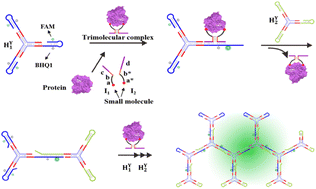A programmable catalytic molecular nanomachine for highly sensitive protein and small molecule detection†
Abstract
Herein, we report the construction of a programmable catalytic molecular nanomachine based on a cross-linked catalytic hairpin assembly (CCHA) reaction for the one-step highly sensitive detection of proteins and small molecules. In this system, when the recognition elements attached on split initiators bind to the target proteins, it can trigger the cascade of the CCHA reaction, resulting in the formation of many macromolecular fluorescent products for signaling. This platform couples the advantages of highly efficient DNA-based nanotechnology with specific protein-small molecule interactions. We demonstrated the sensitive detection of streptavidin and anti-digoxigenin antibody with detection limits as low as 48.8 pM and 0.85 nM, respectively. This nanomachine also demonstrated its flexibility in the nanomolar detection of corresponding small molecules, such as biotin and digoxigenin, using a competitive method. In addition, the nanomachine was robust enough to perform well with human serum samples. Overall, this programmable catalytic molecular nanomachine provides a versatile platform for the detection of proteins and small molecules by replacing the recognition elements, which can promote the development of DNA nanotechnology in disease diagnosis and therapeutic drug monitoring.



 Please wait while we load your content...
Please wait while we load your content...